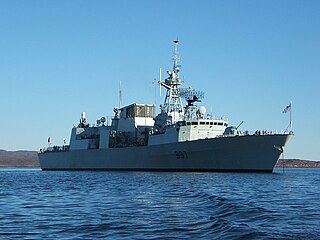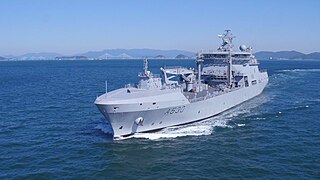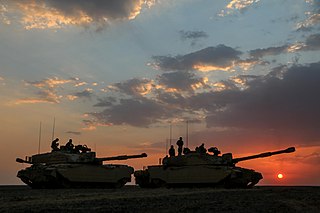
The Swedish Armed Forces are the armed forces of the Kingdom of Sweden, tasked with the defence of the country as well as with promoting Sweden's wider interests, supporting international peacekeeping, and providing humanitarian aid. It consists of four service branches: the Swedish Army, the Swedish Air Force and the Swedish Navy, as well as a military reserve force, the Home Guard. Since 1994, all Swedish military branches are organised within a single unified government agency, the Swedish Armed Forces Headquarters, which is headed by the Supreme Commander, even though the individual services maintain their distinct identities.

The Royal Norwegian Air Force (RNoAF) is the air force of Norway. It was established as a separate arm of the Norwegian Armed Forces on 10 November 1944. The RNoAF's peacetime establishment is approximately 2,430 employees. 600 personnel also serve their draft period in the RNoAF. After mobilization, the RNoAF would consist of approximately 5,500 personnel.

Standing Royal Navy deployments is a list of operations and commitments undertaken by the United Kingdom's Royal Navy on a worldwide basis. The following list details these commitments and deployments sorted by region and in alphabetical order. Routine deployments made by the Navy's nuclear-powered submarines and their location of operations is classified.

The Norwegian Armed Forces is the military organization responsible for the defence of Norway. It consists of five branches, the Norwegian Army, the Royal Norwegian Navy, which includes the Coast Guard, the Royal Norwegian Air Force, the Home Guard, and Norwegian Cyber Defence Force as well as several joint departments.

The Fridtjof Nansen-class frigates are a class of frigates that are the main surface combatant units of the Royal Norwegian Navy. The ships are named after famous Norwegian explorers, with the lead ship of the class bearing the name of Fridtjof Nansen. Five ships were ordered from Spanish shipbuilder Bazan.

HMCS Halifax is a Halifax-class frigate that has served in the Royal Canadian Navy and Canadian Forces since 1992. Halifax is the lead ship in her class which is the name for the Canadian Patrol Frigate Project. She is the second vessel to carry the designation HMCS Halifax. She carries the hull classification symbol FFH 330.

Marinejegerkommandoen (MJK) is the maritime/naval special warfare unit of the Norwegian Armed Forces and was established in 1953.

Standing NATO Maritime Group One (SNMG1) is one of NATO's standing naval maritime immediate reaction forces. SNMG1 consists of four to six destroyers and frigates. Its role is to provide NATO with an immediate operational response capability.

HNoMS Helge Ingstad was a Fridtjof Nansen-class frigate of the Royal Norwegian Navy. The vessel was ordered on 23 June 2000 and constructed by Navantia in Spain. The ship was launched on 23 November 2007 and commissioned on 29 November 2009. Named for Helge Ingstad, a Norwegian explorer, the Fridtjof Nansen class are capable of anti-air, anti-submarine and surface warfare. On 8 November 2018, HNoMS Helge Ingstad was in a collision with the tanker Sola TS in Norwegian waters just outside Sture Terminal. Helge Ingstad was severely damaged in the collision and ran aground. On 13 November 2018, the ship sank where she had run aground and became a constructive total loss.

HMCS Fredericton is a Halifax-class frigate that has served in the Canadian Forces since 1994. Fredericton is the eighth ship in her class which is based on the Canadian Patrol Frigate Project. She is the second vessel to carry the name. Fredericton serves on MARLANT missions protecting Canada's sovereignty in the Atlantic Ocean and enforcing Canadian laws in its territorial sea and Exclusive Economic Zone. Fredericton has also been deployed on missions throughout the Atlantic and to the Indian Ocean; specifically the Persian Gulf and Arabian Sea on anti-terrorism operations. Fredericton has also participated in several NATO missions, patrolling the Atlantic Ocean as part of Standing Naval Force Atlantic (STANAVFORLANT) and its successor Standing NATO Response Force Maritime Group 1 (SNMG1). The frigate is assigned to Maritime Forces Atlantic (MARLANT) and is homeported at CFB Halifax.

HNLMS De Ruyter is a De Zeven Provinciën-class frigate of the Royal Netherlands Navy. She was laid down in 2000, launched in 2002, and commissioned in 2004, the third ship of her class to enter service. The frigate is named after Dutch admiral Michiel de Ruyter (1607–1676).
Northern Viking is an annual NATO exercise held in Iceland. The exercises were held biennially until 2006 when the frequency was increased. The purpose of the exercise is to test the capabilities of Iceland and its NATO allies, as well as increase the readiness of the forces involved and their inter-operability.

The Joint Expeditionary Force (Maritime) (or JEF(M)) (formerly the Response Force Task Group (RFTG), and prior to that the Joint Rapid Reaction Force (JRRF)), is the Royal Navy's contribution to the Joint Expeditionary Force (JEF) maintained at very high-readiness and available at short notice to respond to unexpected global events. In addition to the Royal Navy and the Royal Marines, the JEF(M) also includes elements of the British Army and the Royal Air Force. While it is primarily poised to conduct war-fighting or strike operations, the JEF(M) is capable of undertaking a diverse range of activities such as evacuation operations, disaster relief or humanitarian aid.

Sachsen is a Sachsen-class frigate of the German Navy, the lead ship of her class.

Naval Striking and Support Forces NATO (STRIKFORNATO) is a naval command of Allied Command Operations of North Atlantic Treaty Organization (NATO). It is part of the NATO Force Structure. STRIKFORNATO is commanded by the Commander of the United States Sixth Fleet, and it is the only command capable of leading an expanded maritime task force. Its predecessor was Naval Striking and Support Forces Southern Europe (STRIKFORSOUTH); the name change took place in 2004.
Jegertroppen is an all female special operations forces unit of the Special Operations Commando (FSK) of the Norwegian Special Operation Forces (NORSOF).

HNoMS Maud is a replenishment oiler constructed at Daewoo Shipbuilding & Marine Engineering in South Korea. She was built on behalf of the Norwegian Defense Materials Agency Forsvarsmateriell, for service in the Royal Norwegian Navy.

Exercise Saif Sareea is a series of military exercises undertaken by the United Kingdom and Oman which first began in 1986 and most recently took place in 2018.

The Helge Ingstad collision was a ship collision between the Norwegian frigate Helge Ingstad and the Maltese tanker Sola TS. The accident happened on the night of 8 November 2018 in the Hjeltefjorden north of the Sture Terminal in Øygarden.




















